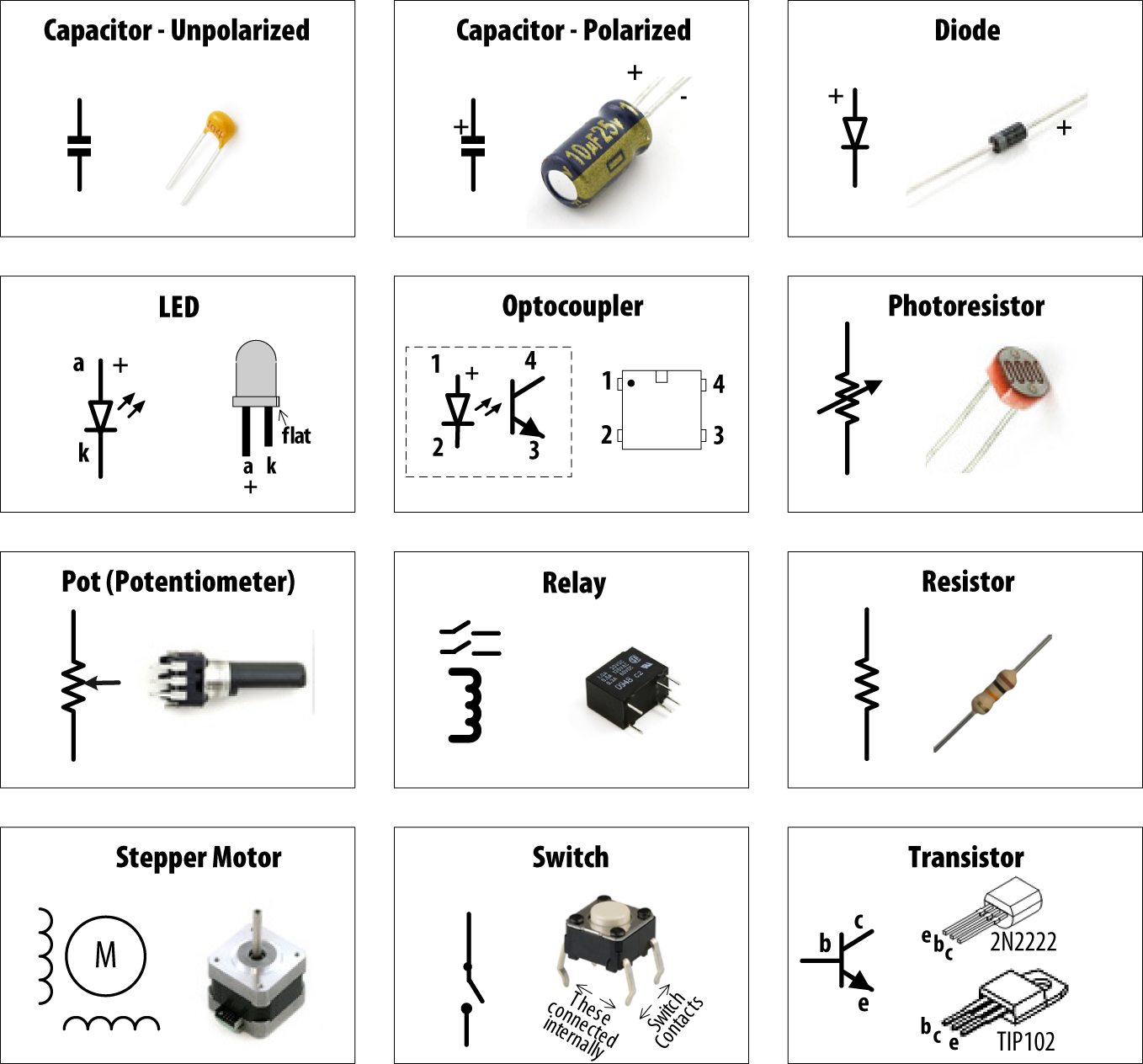Electronic Components
If you are just starting out with electronic components, you may want to purchase a beginner’s starter kit that contains the basic components needed for many of the recipes in this book. These usually include the most common resistors, capacitors, transistors, diodes, LEDs, and switches.
Here are some popular choices:
- Arduino Starter Kit
- Getting Started with Arduino kit
-
https://www.makershed.com/products/getting-started-with-arduino-kit
- SparkFun Tinker Kit
- Adafruit MetroX Classic Kit
- ARDX - The starter kit for Arduino
-
https://www.seeedstudio.com/ARDX-The-starter-kit-for-Arduino.html
You can also purchase the individual components for your project, as shown in Figure A-1. The following sections provide an overview of common electronic components.

Schematic representation of common components
Capacitor
Capacitors store an electrical charge for a short time and are used in digital circuits to filter (smooth out) dips and spikes in electrical signals. The most commonly used capacitor is the nonpolarized ceramic capacitor; for example, a 100 nF disc capacitor used for decoupling (reducing noise spikes). Electrolytic capacitors can generally store more charge than ceramic caps and are used for higher current circuits, such as power supplies and motor circuits. Electrolytic capacitors are usually polarized, and the negative leg (marked with a minus sign) must be connected to ground (or to a point with lower voltage than the positive leg). Chapter 8 contains examples showing how capacitors are used in motor circuits.
Diode
Diodes permit current to flow in one direction and block it in the other direction. Most diodes have a band (see Figure A-1) to indicate the cathode (negative) end.
Diodes such as the 1N4148 can be used for low-current applications such as the levels used on Arduino digital pins. The 1N4001 diode is a good choice for higher currents (up to 1 amp).
Integrated Circuit
Integrated circuits contain electronic components packaged together in a convenient chip. These can be complex, like the Arduino controller chip that contains thousands of transistors, or as simple as the optical isolator component used in Chapter 10 that contains just two semiconductors. Some integrated circuits (such as the Arduino chip) are sensitive to static electricity and should be handled with care.
Keypad
A keypad is a matrix of switches used to provide input for numeric digits. See Chapter 5.
LED
An LED (light-emitting diode) is a diode that emits light when current flows through the device. As they are diodes, LEDs only conduct electricity in one direction. See Chapter 7.
Motor (DC)
Motors convert electrical energy into physical movement. Most small direct current (DC) motors have a speed proportional to the voltage, and you can reverse the direction they move by reversing the polarity of the voltage across the motor. Most motors need more current than the Arduino pins provide, and a component such as a transistor is required to drive the motor. See Chapter 8.
Optocoupler
Optocouplers (also called optoisolators) provide electrical separation between devices. This isolation allows devices that operate with different voltage levels to work safely together. See Chapter 10.
Photocell (Photoresistor)
Photocells are variable resistors whose resistance changes with light. See Chapter 6.
Piezo
A small ceramic transducer that produces sound when pulsed, a Piezo is polarized and may have a red wire indicating the positive end and a black wire indicating the side to be connected to ground. See Chapter 9.
Pot (Potentiometer)
A potentiometer (pot for short) is a variable resistor. The two outside terminals act as a fixed resistor. A movable contact called a wiper (or slider) moves across the resistor, producing a variable resistance between the center terminal and the two sides. See Chapter 5.
Relay
A relay is an electronic switch—circuits are opened or closed in response to a voltage on the relay coil, which is electrically isolated from the switch. Most relay coils require more current than Arduino pins provide, so they need a transistor to drive them. See Chapter 8.
Resistor
Resistors resist the flow of electrical current. A voltage flowing through a resistor will limit the current proportional to the value of the resistor (see Ohm’s law). The bands on a resistor indicate the resistor’s value. Chapter 7 contains information on selecting a resistor for use with LEDs.
Solenoid
A solenoid produces linear movement when powered. Solenoids have a metallic core that is moved by a magnetic field created when passing current through a coil. See Chapter 8.
Speaker
A speaker produces sound by moving a diaphragm (the speaker cone) to create sound waves. The diaphragm is driven by sending an audio frequency electrical signal to a coil of wire attached to the diaphragm. See Chapter 9.
Stepper Motor
A stepper motor rotates a specific number of degrees in response to control pulses. See Chapter 8.
Switch
A switch makes and breaks an electrical circuit. Many of the recipes in this book use a type of push button switch known as a tactile switch. Tactile switches have two pairs of contacts that are connected together when the button is pushed. The pairs are wired together, so you can use either one of the pair. Switches that make contact when pressed are called Normally Open (NO) switches. See Chapter 5.
Transistor
Transistors are used to switch on high currents or high voltages in digital circuits. In analog circuits, transistors are used to amplify signals. A small current through the transistor base results in a larger current flowing through the collector and emitter.
For currents up to .5 amperes (500 mA) or so, the 2N2222 transistor is a widely available choice. For currents up to 5 amperes, you can use the TIP120 transistor.
See Chapters 7 and 8 for examples of transistors used with LEDs and motors.
See Also
For more comprehensive coverage of basic electronics, see the list of books in Recipe .
